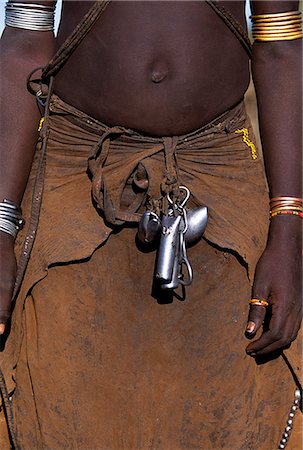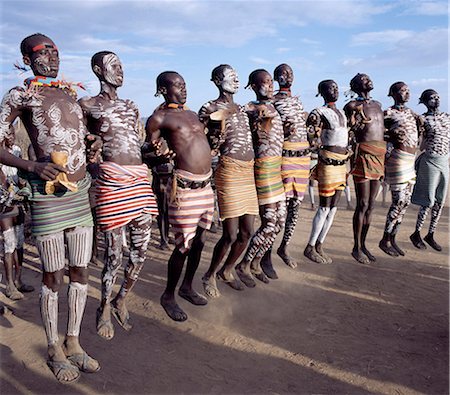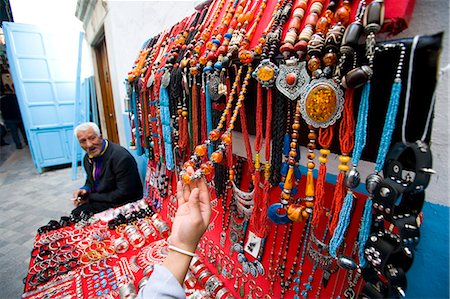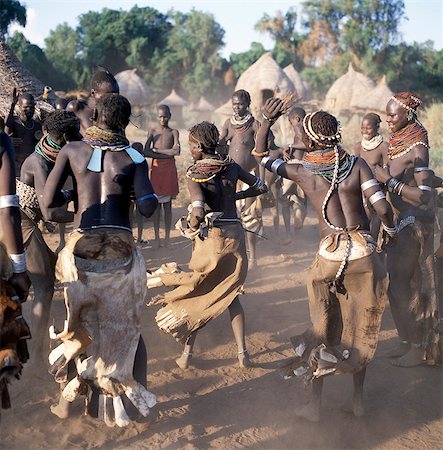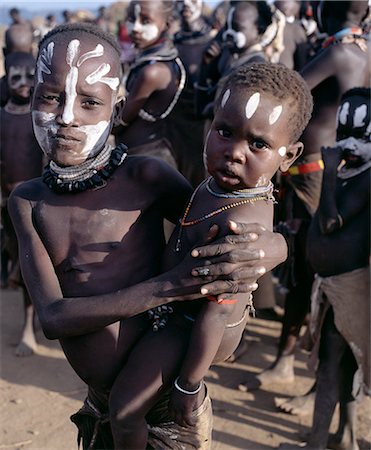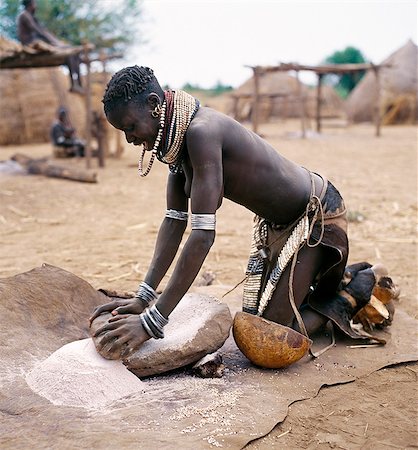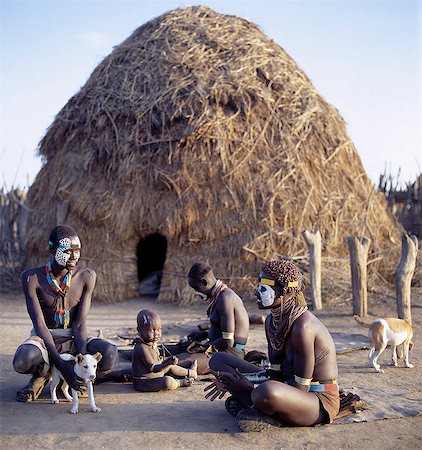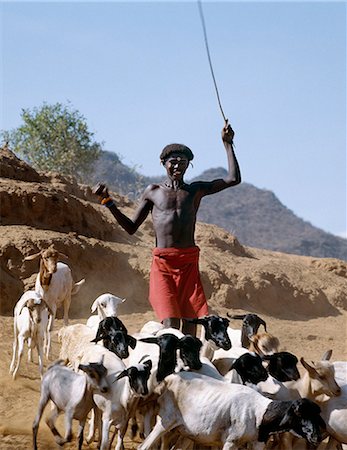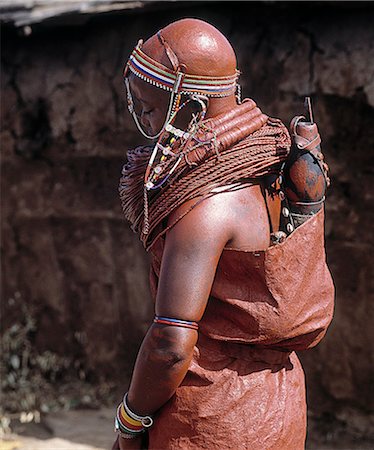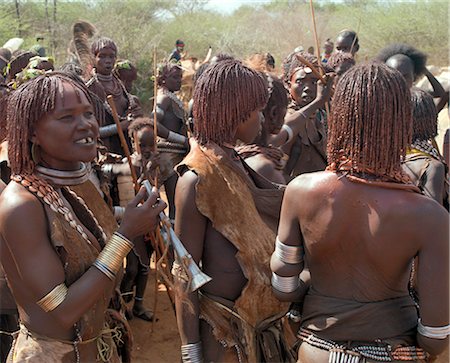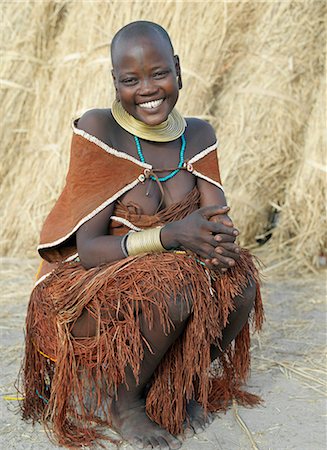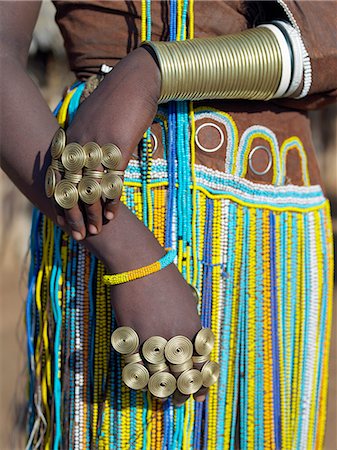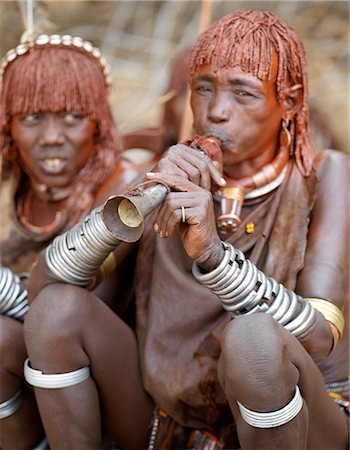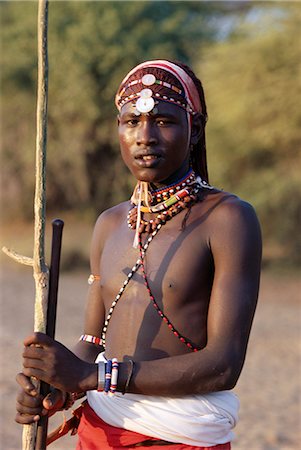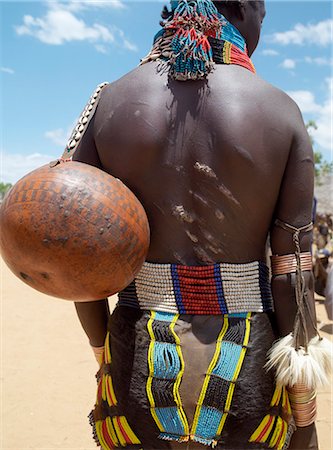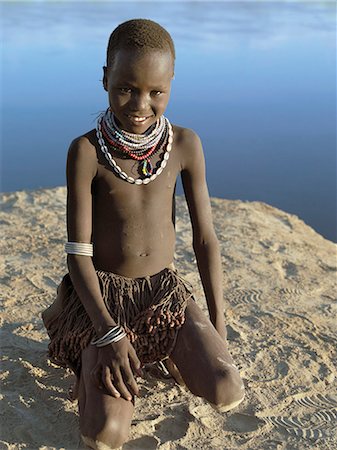-
Colourful traditional African souvenirs on beachfront, Durban, KwaZulu-Natal, South Africa
Rights-Managed
-
A young Dassanech girl wears a leather skirt,metal bracelets and amulets and layers of bead necklaces. Much the largest of the tribes in the Omo Valley numbering around 50,000,the Dassanech (also known as the Galeb,Changila or Merille) are Nilotic pastoralists and agriculturalists.
Rights-Managed
-
Colourful traditional African souvenirs on beachfront, Durban, KwaZulu-Natal, South Africa
Rights-Managed
-
An Afar girl from the Sultanate of Tadjoura wears exotic gold jewellery for marriage and other important celebrations. Although some of this jewellery will be made locally,other pieces will have been bought in Arabia,Ethiopia and the Indian sub-continent.
Rights-Managed
-
A Dassanech girl braids her sister's hair at her village in the Omo Delta. Much the largest of the tribes in the Omo Valley numbering around 50,000,the Dassanech (also known as the Galeb,Changila or Merille) and Nilotic pastoralists and agriculturalists.
Rights-Managed
-
A Karo woman with her face painted in preparation for a dance in the village of Duss. A small Omotic tribe related to the Hamar, who live along the banks of the Omo River in southwestern Ethiopia, the Karo are renowned for their elaborate body painting using white chalk, crushed rock and other natural pigments. She is wearing a goatskin apron and carries a leather belt decorated with cowrie shells
Rights-Managed
-
A young Dassanech girl wears a leather skirt,metal bracelets and amulets and layers of bead necklaces. A long leather strap decorated with cowrie shells hangs down her back. Much the largest of the tribes in the Omo Valley numbering around 50,000,the Dassanech (also known as the Galeb,Changila or Merille) are Nilotic pastoralists and agriculturalists.
Rights-Managed
-
A Karo woman sits with child. A small Omotic tribe related to the Hamar,who live along the banks of the Omo River in southwestern Ethiopia,the Karo are renowned for their elaborate body painting using white chalk,crushed rock and other natural pigments. Typically for a Karo woman,the mother has ochred her hair in tight ringlets and has a ring through her bottom lip.
Rights-Managed
-
A Karo women stands in the doorway to her hut in the village of Duss. A small Omotic tribe related to the Hamar, who live along the banks of the Omo River in southwestern Ethiopia, the Karo are renowned for their elaborate body painting using white chalk, crushed rock and other natural pigments. In addition to painting her face she has decorated her body with whorls of goat hair tied by leather co
Rights-Managed
-
A young Karo girl in the doorway of her hut in the village of Duss. A small Omotic tribe related to the Hamar,who live along the banks of the Omo River in southwestern Ethiopia,the Karo are renowned for their elaborate body painting using white chalk,crushed rock and other natural pigments.
Rights-Managed
-
An attractive woman at Bati market.Situated on top of the western scarp of the Abyssinian Rift, Bati is the largest open air market in Ethiopia.Nomads and their camels trek long distances every week from the harsh low lying deserts to barter with Amhara and Oromo farmers living in the fertile highlands.
Rights-Managed
-
During Samburu wedding celebrations,warriors resplendent with long Ochred braids dance with young girls who have put on all their finery for the occasion. Both warriors and girls smear their faces,necks and shoulders with red ochre mixed with animal fat to enhance their appearance. Two spears are tipped with ostrich-feather pompoms.
Rights-Managed
-
Karo men excel in body art. Before a dance, they will decorate their faces and torsos elaborately using local white chalk, pulverised rock and other natural pigments. While older men style their hair with clay, young men prefer to braid theirs.Every man carries a wooden stool, which doubles as a pillow at night.The Karo are a small tribe living in three main villages along the lower reaches of the
Rights-Managed
-
A Samburu woman resplendent in her beaded necklaces and numerous bracelets makes best use of a large rainwater pond to wash herself. Water is scarce in much of Samburuland.
Rights-Managed
-
A Nyangatom woman grinds sorghum using two stones. Typical of her tribe,she wears a heavily beaded calfskin skirt,multiple layers of bead necklaces and metal bracelets and amulets. The Nyangatom or Bume are a Nilotic tribe of semi-nomadic pastoralists who live along the banks of the Omo River in south-western Ethiopia.
Rights-Managed
-
A young Datoga man tends his family's livestock on the plains east of Lake Manyara in Northern Tanzania.The Datoga (known to their Maasai neighbours as the Mang'ati and to the Iraqw as Babaraig) live in northern Tanzania and are primarily pastoralists..
Rights-Managed
-
A young Dassanech girl holds her little brother. She wears a leather skirt with an elaborate fringe of wooden and metal tassles. Much the largest of the tribes in the Omo Valley numbering around 50,000,the Dassanech (also known as the Galeb,Changila or Merille) are Nilotic pastoralists and agriculturalists.
Rights-Managed
-
During Samburu wedding celebrations,married women congregate apart from the warriors and young girls to sing in praise of the couple and to dance.
Rights-Managed
-
A Samburu Warrior drives his goats along the wide,sandy seasonal watercourse of the Milgis where waterholes dug by the Samburu in the dry season are a lifeline for pastoralists in this semi-arid region of their district.
Rights-Managed
-
Song is an art form ingrained in Turkana culture. At the end of a dance session,the participants invariably enjoy the Song of the Bulls. Each young man will take centre-stage to extol the praises of his favourite ox. He will explain how it came into his possession,its distinguishing traits and with outstretched arms,imitate the shape of its horns.
Rights-Managed
-
A Turkana girl with a large gourd-like container used as a receptacle for water or milk. In the absence of gourds,the Turkana carve their containers from soft wood,such as that from the common commiphora species,which thrives in semi-arid country.
Rights-Managed
-
Kenya, Samburu District. A Samburu woman, wearing intricate beaded necklaces, leans against her mud hut towards the end of the day.
Rights-Managed
-
A Nyangatom girl weaves a grass basket. The Nyangatom or Bume are a Nilotic tribe of semi-nomadic pastoralists who live along the banks of the Omo River in south-western Ethiopia.
Rights-Managed
-
During Samburu wedding celebrations,married women congregate apart from the warriors and young girls to sing in praise of the couple and to dance.
Rights-Managed
-
A Nyangatom woman wears multiple layers of beads in necklaces, an elaborately beaded calfskin skirt and metal bracelets, amulets and anklets. She is standing beside a temporary beehive construction of sticks, grass and leaves built to provide shade for her goats. The Nyangatom or Bume are a Nilotic tribe of semi-nomadic pastoralists who live along the banks of the Omo River in south western Ethio
Rights-Managed
-
Song is an art form ingrained in Turkana culture. After months of separation,young men and girls gather together during the rains when grass is abundant and life is relatively easy for a while. The Turkana have a rich repertoire of at least twenty dances,most of which are quite energetic.
Rights-Managed
-
Two young Karo girls stand in front of the massive trunk of a fig tree. A small Omotic tribe related to the Hamar,who live along the banks of the Omo River in southwestern Ethiopia,the Karo are renowned for their elaborate body painting using white chalk,crushed rock and other natural pigments.
Rights-Managed
-
Turkana women and girls are responsible for watering livestock,which is unusual among pastoral societies. Here,a young girl waters goats from a waterhole dug in the sand of a seasonal watercourse. Her young brother will control the flow of stock to the water trough. In the background,a man digs out another waterhole; they have to been deepened regularly towards the end of the dry season.
Rights-Managed
-
Song is an art form ingrained in Turkana culture. At the end of a dance session,the participants invariably enjoy the Song of the Bulls. Each young man will take centre-stage to extol the praises of his favourite ox. He will explain how it came into his possession,its distinguishing traits and with outstretched arms,imitate the shape of its horns.
Rights-Managed
-
An elder of the Karo tribe,a small Omotic tribe related to the Hamar,who live along the banks of the Omo River in southwestern Ethiopia. The Karo are renowned for their elaborate body painting using white chalk,crushed rock and other natural pigments. This man also has a clay hairdo typical of tribal elders. Like most adult males he carries a rifle.
Rights-Managed
-
A Karo mother and child. Heavy metal bracelets are common among older women.The Karo are a small tribe living in three main villages along the lower reaches of the Omo River in southwest Ethiopia.
Rights-Managed
-
Kenya, Samburu District. A tourist attempting to jump as high as a Samburu warrior, in the dry river bed of the Ewaso Nyiro.
Rights-Managed
-
Song is an art form ingrained in Turkana culture. At the end of a dance session,the participants invariably enjoy the Song of the Bulls. Each young man will take centre-stage to extol the praises of his favourite ox. He will explain how it came into his possession,its distinguishing traits and with outstretched arms,imitate the shape of its horns.
Rights-Managed
-
A Mursi girl, accompanied by her dog, carries a large clay pot to collect water from the Omo River. Her earlobes are already pierced and extended, and decorated with round clay discs.She is dressed in skins, attractively decorated with thin stripes.The culture, social organisation, customs and values of the people have changed little.
Rights-Managed
-
A Datoga young man in traditional attire.His braids are embellished with beads and aluminium can openers.Many of his white plastic bracelets are beautifully decorated with abstract and geometrical designs; long ago these bracelets would have been made of ivory.
Rights-Managed
-
The invited guests at a Samburu wedding gather together to sing in praise of the couple and to dance. Celebrations will go on late into the night.
Rights-Managed
-
A young Dassanech girl holds her little brother. She wears a leather skirt with an elaborate fringe of wooden and metal tassles. Much the largest of the tribes in the Omo Valley numbering around 50,000,the Dassanech (also known as the Galeb,Changila or Merille) are Nilotic pastoralists and agriculturalists.
Rights-Managed
-
A Dassanech woman winnows grain by pouring it from her metal tin and letting it fall onto a calfskin. Much the largest of the tribes in the Omo Valley numbering around 50,000,the Dassanech (also known as the Galeb,Changila or Merille) and Nilotic pastoralists and agriculturalists.
Rights-Managed
-
Female tourist at jewellery stall,Central Medina / Souq,Tunis,Tunisia,North Africa
Rights-Managed
-
A lively Nyangatom dance is enjoyed by villagers in the late afternoon.The elevated houses in the background are both homes and granaries, which have been built to withstand flooding when the Omo River bursts its banks The Nyangatom are one of the largest tribes and arguably the most warlike people living along the Omo River in Southwest Ethiopia.
Rights-Managed
-
Karo men excel in body art. Before a dance, they will decorate their faces and torsos elaborately using local white chalk, pulverised rock and other natural pigments. While older men style their hair with clay, young men prefer to braid theirs.Every man carries a wooden stool, which doubles as a pillow at night.The Karo are a small tribe living in three main villages along the lower reaches of the
Rights-Managed
-
The Karo of the Lower Omo River excel in body art. They decorate their faces and torsos elaborately using local white chalk, pulverised rock and other natural pigments. Even young children daub their faces before a dance.The Karo are a small tribe living in three main villages along the lower reaches of the Omo River in southwest Ethiopia.
Rights-Managed
-
A young Nyangatom woman carries her baby on her hip in an elaborately braided papoose. Her hair has been reddened with a mixture of ochre and animal fat. Typical of her tribe, she wears a calfskin skirt, multiple layers of bead necklaces and metal bracelets and amulets. The Nyangatom or Bume are a Nilotic tribe of semi nomadic pastoralists who live along the banks of the Omo River in south western
Rights-Managed
-
Karo men excel in body art. Before a dance, they will decorate their faces and torsos elaborately using local white chalk, pulverised rock and other natural pigments. While older men style their hair with clay, young men prefer to braid theirs.Every man carries a wooden stool, which doubles as a pillow at night.The Karo are a small tribe living in three main villages along the lower reaches of the
Rights-Managed
-
An elder of the Karo tribe sits with his wife and child. A small Omotic tribe related to the Hamar,who live along the banks of the Omo River in southwestern Ethiopia,the Karo are renowned for their elaborate body painting using white chalk,crushed rock and other natural pigments. This man also has a clay hairdo typical of tribal elders. Like most adult males he carries a rifle.
Rights-Managed
-
A Nyangatom woman stands with her baby on her hip beside her grass hut in his temporary camp. Nyangatom married women wear elaborately beaded skirts which reach the ground at the back and often have panels of different coloured calkfskin sewn into the tail The Nyangatom or Bume are a Nilotic tribe of semi nomadic pastoralists who live along the banks of the Omo River in south western Ethiopia.
Rights-Managed
-
A Nyangatom girl churns butter in a gourd suspended in the entrance to her hut. Typical of her tribe,she is wearing multiple layers of beads in necklaces,and an elaborately beaded calfskin skirt. The Nyangatom or Bume are a Nilotic tribe of semi-nomadic pastoralists who live along the banks of the Omo River in south-western Ethiopia.
Rights-Managed
-
A Nyangatom woman grinds sorghum using a flat stone.The Nyangatom are one of the largest tribes and arguably the most warlike people living along the Omo River in Southwest Ethiopia.They form a part of the Ateger speaking people a cluster of seven eastern Nilotic tribes to which the Turkana of Northern Kenya and the Karamajong of Eastern Uganda belong.
Rights-Managed
-
An old Dassanech man wearing a traditional metal lip ornament and metal earrings. His broad ivory armbands and his ivory tobacco container hanging round his neck, are uncommon because elephants no longer frequent the Omo Delta.The Dassanech people live in the Omo Delta of southwest Ethiopia, one of the largest inland deltas in the world.
Rights-Managed
-
Kenya, Samburu District. Samburu warriors and young girls sing and dance in the dry river bed of the Ewaso Nyiro River.
Rights-Managed
-
A Datoga woman relaxes outside her thatched house.The traditional attire of Datoga women includes beautifully tanned and decorated leather dresses and coiled brass armulets and necklaces. Extensive scarification of the face with raised circular patterns is not uncommon among women and girls.
Rights-Managed
-
Maasai beadwork at the Predator Compensation Fund Pay Day, Mbirikani Group Ranch, Amboseli-Tsavo eco-system, Kenya, East Africa, Africa
Rights-Managed
-
Shaded from the hot sun, a Karo woman grinds sorghum using large flat stones.It is customary for females of the tribe when in their teens to make a small hole in the flesh below their lower lips into which they put an ornament, this woman has used a small nail. Numerous heavy metal bracelets are worn by married womenThe Karo are a small tribe living in three main villages along the lower reaches o
Rights-Managed
-
In the late afternoon, family and friends sit outside a high dome roofed Karo home.The Karo excel in body art. Before a dance, they will decorate their faces and torsos elaborately using local white chalk, pulverised rock and other natural pigments. The polka dot or guinea fowl plumage effect is popular.
Rights-Managed
-
A young Samburu herdsman drives goats towards a Waterhole along the Milgis - a wide,sandy seasonal watercourse which is a lifeline for pastoralists in the low-lying semi-arid region of their district. The hair style of the young man denotes his status as an uncircumcised youth.
Rights-Managed
-
Turkana women and girls are responsible for watering livestock,which is unusual among pastoral societies. Here,a girl waters cattle from a Waterhole dug in the sand of a seasonal watercourse. The Turkana manipulate the horns of their ox's into perfect symmetry or any whimsical shape that takes the owner's fancy.
Rights-Managed
-
A Samburu bride waits pensively outside her new home until she is enticed in with promises of cattle.Her wedding gown is made of three goatskins, which are well oiled and covered in red ochre.She carries on her back a gourd full of milk and a small wooden jar containing butter.She now wears the mporro necklace of married women.
Rights-Managed
-
Kenya, Masai Mara National Reserve. A safari guide spotting for tourists whilst out on safari.
Rights-Managed
-
An attractive woman at Bati market.Situated on top of the western scarp of the Abyssinian Rift, Bati is the largest open air market in Ethiopia.Nomads and their camels trek long distances every week from the harsh low lying deserts to barter with Amhara and Oromo farmers living in the fertile highlands.
Rights-Managed
-
Detail of the beadworks created by the women's groups in Kenya, East Africa, Africa
Rights-Managed
-
A group of Hamar women at a Jumping of the Bull ceremony.The Hamar are semi nomadic pastoralists of Southwest Ethiopia whose women wear striking traditional dress and style their red ochred hair mop fashion.The Jumping of the Bull ceremony is a rite of passage for young men.
Rights-Managed
-
A Mursi woman wearing a large clay lip plate and ear ornaments to match.Shortly before marriage, a girls lower lip will be pierced and progressively stretched over a year or so while some of her teeth will be removed for the plate to fit snugly. The size of the lip plate often determines the quantum of the bride price. The reason for this singular practice is not fully understood but Mursi women
Rights-Managed
-
A Hamar woman blows a tin trumpet at a Jumping of the Bull ceremony.The Hamar are semi nomadic pastoralists of Southwest Ethiopia whose women wear striking traditional dress and style their red ochred hair mop fashion.The Jumping of the Bull ceremony is a rite of passage for young men.
Rights-Managed
-
A Datoga woman relaxes outside her thatched house.The traditional attire of Datoga women includes beautifully tanned and decorated leather dresses and coiled brass armbands and necklaces.Scarification of the face is not uncommon among women and girls.
Rights-Managed
-
A Hamar woman wears an intricately beaded leather skirt and bells round her legs as well as carrying a tin horn,to the bull-jumping ceremony of her brother,a rite of passage to manhood.
Rights-Managed
-
Hamar women dance at a Jumping of the Bull ceremony.The Hamar are semi nomadic pastoralists of Southwest Ethiopia whose women wear striking traditional dress and style their red ochred hair mop fashion. The Jumping of the Bull ceremony is a rite of passage for young men.After the ceremony, the initiate attains full manhood and is permitted to marry.
Rights-Managed
-
A Hamar woman at a Jumping of the Bull ceremony.The Hamar are semi nomadic pastoralists of Southwest Ethiopia whose women wear striking traditional dress and style their red ochred hair mop fashion.The Jumping of the Bull ceremony is a rite of passage for young men.
Rights-Managed
-
A pregnant Nyangatom woman in traditional attire outside her neatly thatched home.The Nyangatom are one of the largest tribes and arguably the most warlike people living along the Omo River in Southwest Ethiopia.
Rights-Managed
-
The finery of a Datoga woman.The traditional attire of Datoga women includes beautifully tanned and decorated leather dresses and coiled brass ornaments of every description. Yellow and light blue are the preferred colours of the beads they wear.
Rights-Managed
-
A Hamar woman blows a tin trumpet at a Jumping of the Bull ceremony.The Hamar are semi nomadic pastoralists of Southwest Ethiopia whose women wear striking traditional dress and style their red ochred hair mop fashion.The Jumping of the Bull ceremony is a rite of passage for young men.
Rights-Managed
-
A Mursi woman wearing a large clay lip plate and ear ornaments to match.Shortly before marriage, a girls lower lip will be pierced and progressively stretched over a year or so while some of her teeth will be removed for the plate to fit snugly.The size of the lip plate often determines the quantum of the bride price. The reason for this singular practice is not fully understood but Mursi women
Rights-Managed
-
A Hamar girl in traditional attire. Her leather skirt is made from the twisted strands of goatskin. Cowries are always popular to embellish a woman's or girl's appearance.The Hamar are semi-nomadic pastoralists who live in harsh country around the Hamar Mountains of Southwest Ethiopia.
Rights-Managed
-
A Hamar woman dances around cattle while she blows a tin trumpet at a Jumping of the Bull ceremony.The Hamar are semi nomadic pastoralists of Southwest Ethiopia whose women wear striking traditional dress and style their red ochred hair mop fashion.The Jumping of the Bull ceremony is a rite of passage for young men.
Rights-Managed
-
A Hamar woman blows a tin trumpet at a Jumping of the Bull ceremony.The Hamar are semi nomadic pastoralists of Southwest Ethiopia whose women wear striking traditional dress and style their red ochred hair mop fashion.The Jumping of the Bull ceremony is a rite of passage for young men.
Rights-Managed
-
A Mursi child is carried safely in her mothers decorated leather garments.The Mursi speak a Nilotic language and have affinities with the Shilluk and Anuak of eastern Sudan.They live in a remote area of southwest Ethiopia along the Omo River.
Rights-Managed
-
Hamar women dance around cattle at a Jumping of the Bull ceremony as a rainbow gives colour to a threatening sky overhead.The Hamar are semi nomadic pastoralists of Southwest Ethiopia whose women wear striking traditional dress and style their red ochre hair mop fashion.The phallic protrusion of the women's chokers denote they are their husbands first wives.The Jumping of the Bull ceremony is a ri
Rights-Managed
-
Young Masai morani or warrior with henna-ed hair and beadwork, Laikipia, Kenya, East Africa, Africa
Rights-Managed
-
African ethnic colorful jewellery necklaces with selective focus
Budget Royalty-Free & Subscription
-
A Mursi woman wearing a large clay lip plate and ear ornaments to match.Shortly before marriage, a girls lower lip will be pierced and progressively stretched over a year or so while some of her teeth will be removed for the plate to fit snugly.The size of the lip plate often determines the quantum of the bride price. The reason for this singular practice is not fully understood but Mursi women
Rights-Managed
-
A beautifully decorated leather skirt of a Hamar woman.The Hamar are semi nomadic pastoralists of Southwest Ethiopia who live in harsh country around the Hamar Mountains of Southwest Ethiopia.Their whole way of life is based on the needs of their livestock.
Rights-Managed
-
A young Nyangatom girl on the banks of the Omo River.The Nyangatom are one of the largest tribes and arguably the most warlike people living along the Omo River in Southwest Ethiopia. They form a part of the Ateger speaking people a cluster of seven eastern Nilotic tribes to which the Turkana of Northern Kenya and the Karamajong of Eastern Uganda belong.
Rights-Managed

